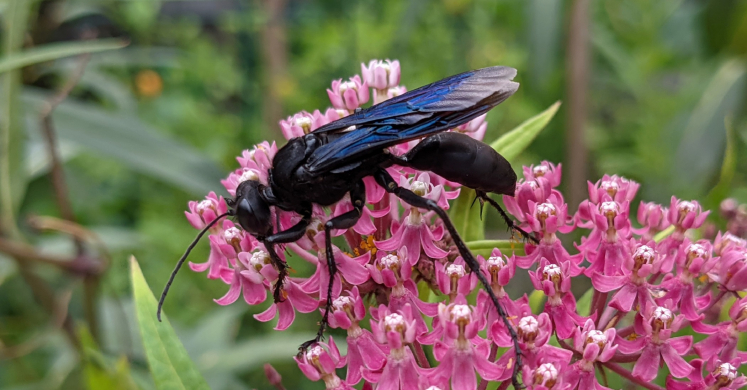Blog

#bioPGH Blog: The Super Spooky Sting
 A resource of Biophilia: Pittsburgh, #bioPGH is a weekly blog and social media series that aims to encourage both children and adults to reconnect with nature and enjoy what each of our distinctive seasons has to offer.
A resource of Biophilia: Pittsburgh, #bioPGH is a weekly blog and social media series that aims to encourage both children and adults to reconnect with nature and enjoy what each of our distinctive seasons has to offer.
It almost sounds like something out of a horror movie: the unsuspecting grasshopper is going about his day, unaware that something has been watching him in the grass. Then suddenly, the blue-black sheen of the watching wasp flickers in the sunlight as she flies into position and quickly stings her grasshopper prey. The sting is not deadly, though — it merely paralyzes. The hunting wasp, always a female, then drags the paralyzed prey back to the multi-chambered burrow that she has dug for her offspring. Each little tunnel chamber will hold one of her offspring and sources of food, like grasshoppers, katydids and crickets. Once she has dragged food into a chamber, she will produce an adhesive to literally glue an egg to its food source, and she then seals up the tunnel so that nothing else can steal the food she has provided. When the egg hatches, the newly emerged larva can immediately begin feeding on its paralyzed (yet…still alive) breakfast. Shudder.
Truth is stranger than fiction, and nature can sometimes seem brutal by human sensibilities. But the great black wasp (Sphex pensylvanicus) is an amazing species that has adapted a high-risk but high pay-off way of feeding its young. When mama wasp carries back food the nest, she ensures that each egg has its own chamber and its own food source. What makes her job extra difficult is that she will even have to be on guard for larger animals like birds trying to steal her hard-earned insect feast!
Aside from their dramatic way of feeding their young, great black wasps are important pollinators and they are one of a number of insects that are often overlooked in conversations surrounding pollinator conservation: solitary wasps. These wasps don’t live in a hive or a large colony; they live alone. Great black wasps in particular are a type of digging wasp that dig out a home underground. Females will actually dig elaborate multi-chambered tunnel systems to ensure her offspring have a safe space to grow up (with their snacks). When not burrowing or collecting food for young, great black wasps are useful pollinators as nectivores (nectar-eaters) that are covered in fine hairs, which catch pollen.
If you see a great black wasp in person (they can be found across most of the Lower 48 states, Mexico and a few Canadian provinces), they are actually quite beautiful insects. Their dark exoskeleton gleams the iridescent blue-black of the namesake, and since they are quite large — the largest females can be almost 1.5 inches — they are hard to miss. And while the sting may be a bit painful, great black wasps are relatively docile and only sting when threatened while the males don’t have stingers.
So the next time you’re outdoors, and you spy a shiny blue-black wasp dragging an entire katydid or grasshopper into a little hole in the ground, just know that nature is a wild place, and a little baby wasp is quite well fed. Enjoy the outdoors!
University of Minnesota - Great Black Wasp
Missouri Dept of Conservation - Great Black Wasp
University of Wisconsin-Milwaukee - Great Black Wasp
Images credits: Cover, Claire O'Neill, CC-BY-NC-4.0;

